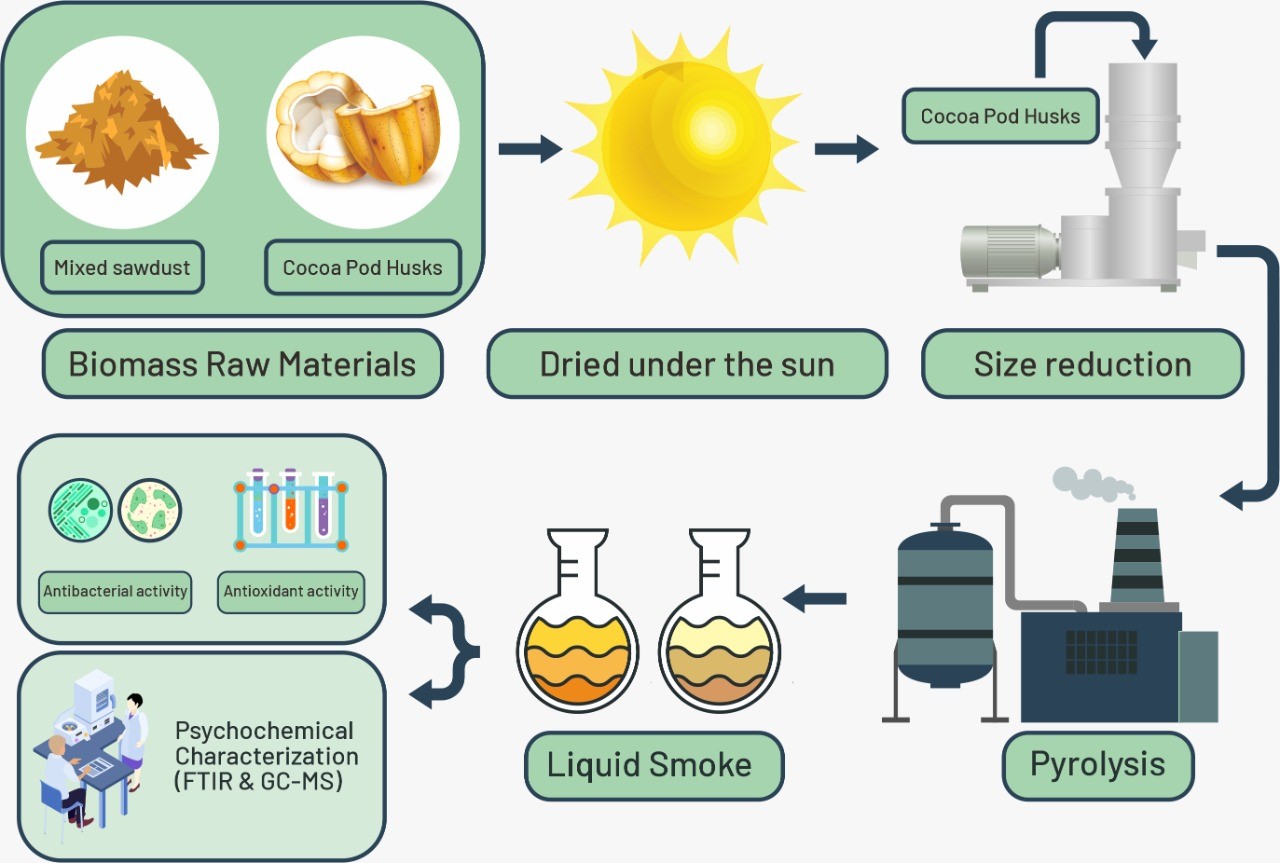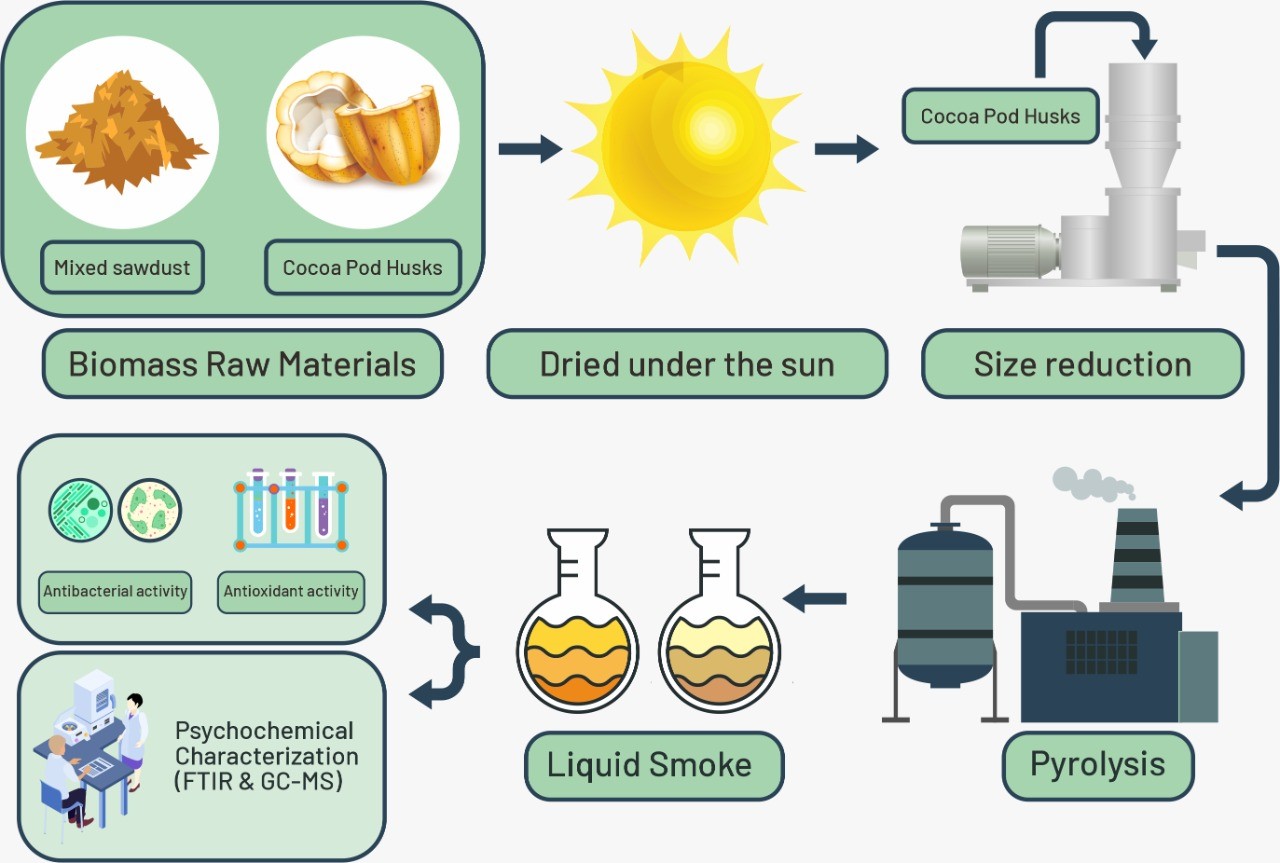Physicochemical Characteristics, Antioxidant and Antibacterial Activities of Liquid Smoke Derived from Mixed Sawdust and Cocoa Pod Husks Biomass
DOI:
https://doi.org/10.48048/tis.2023.4985Keywords:
Pyrolysis, Biomass, Waste, Antioxidant, AntibacterialAbstract
This study aimed to analyze the physicochemical characteristics, antioxidant and antibacterial activities of liquid smoke derived from mixed sawdust (MS) and cocoa pod husks (CPH) biomass. The liquid smoke formed by pyrolysis of MS and CPH biomass (Theobroma cacao L.) has the physical characteristics of brown color, transparrent, has floating solids, and has an acidic pH of 3.79 for MS and 5.43 for CPH. The results of the antibacterial assay of both liquid smokes by agar diffusion method against 3 pathogenic bacterial isolates; Escherichia coli FNCC 0091, Staphylococcus aureus FNCC 0047 and Salmonella typhimurium FNCC 0150 showed positive results with the formation of clear zones around the test discs. Antioxidant activity assay showed that liquid smoke derived from the biomass of MS had an IC50 value of 0.112 mg/mL, more potential than liquid smoke derived from the biomass of CPH, which was 2.060 mg/mL. Liquid smoke chemical composition analyzed by Gas Chromatography-Mass Spectrometry method showed that liquid smoke derived from MS biomass was dominated by acetic acid (64.64 %), phenols (12.08 %) and acetone (5.78 %), while the liquid smoke derived from CPH biomass was dominated by methylamine (37.26 %), acetic acid (24.61 %) and acetone (19.89 %). The acetic acid, phenols, methylamine and acetone content in both liquid smokes thought to play an important role on its antioxidant activities and inhibition of bacterial growth.
HIGHLIGHTS
- Pyrolysis uses biomass as raw material in the form of mixed sawdust from the home furniture industry and CPH which are a by-product of the chocolate processing industry
- The liquid smoke obtained from the pyrolysis of both types of biomass has a unique composition and has antibacterial and antioxidant properties
- The liquid smoke has the potential to be applied as a preservative in food products
GRAPHICAL ABSTRACT
Downloads
Metrics
References
CC Xu, B Liao, S Pang, L Nazari, N Mahmood, MSHK Tushar, A Dutta and MB Ray. Biomass energy. Compr. Energ. Syst. 2018; 1, 770-94.
CMSD Silva, ACO Carneiro, BLC Pereira, BR Vital, ICN Alves and M Magalhaes. Stability to thermal degradation and chemical composition of woody biomass subjected to the torrefaction process. Eur. J. Wood Wood Prod. 2016; 74, 845-50.
S Wang, G Dai, H Yang and Z Luo. Lignocellulosic biomass pyrolysis mechanism: A state-of-the-art review. Prog. Energ. Combust. Sci. 2017; 62, 33-86.
I Miranda, V Sousa and H Pereira. Wood properties of teak (Tectona grandis) from a mature unmanaged stand in East Timor. J. Wood Sci. 2011; 57, 171-8.
R Campos-Vega, KH Nieto-Figueroa and BD Oomah. Cocoa (Theobroma cacao L.) pod husk: Renewable source of bioactive compounds. Trends Food Sci. Technol. 2019; 81, 172-84.
F Lu, J Rodriguez-Garcia, IV Damme, NJ Westwood, L Shaw, JS Robinson, G Warren, A Chatzifragkou, SM Mason, L Gomez, L Faas, K Balcombe, C Srinivasan, F Picchioni, P Hadley and D Charalampopoulos. Valorisation strategies for cocoa pod husk and its fractions. Curr. Opin. Green Sustain. Chem. 2018; 14, 80-8.
S Rawdkuen and P Kaewprachu. Valorization of food processing by-products as smart food packaging materials and its application. In: SA Socaci, AC F?rca?, T Aussenac and L Jean-Claude. (Eds.). Food Preservation and Waste Exploitation. IntechOpen, London, 2019.
JM Lingbeck, P Cordero, CA O’Bryan, MG Johnson, SC Ricke and PG Crandall. Functionality of liquid smoke as an all-natural antimicrobial in food preservation. Meat Sci. 2014; 97, 197-206.
Y Sofiana. Analisis strategi peningkatan produksi mebel di sentra industri kayu (in Indonesian). Humaniora 2011; 2, 1-10.
H Roliadi and G Pari. Energy conversion from woody biomass stuff: Possible manufacture of briquetted charcoal from sawmill-generated sawdust. J. For. Res. 2006; 3, 93-103.
Statista. Production of cocoa in Indonesia 2012-2021. Statista Research Department, Hamburg, Germany, 2022.
T Tuesta-Chavez, J Monteza, MIS Jaimes, GA Ruiz-Pacco, K Changanaqui, JB Espinoza-Suarez, H Alarcon, AM Osorio-Anaya, AC Valderrama-Negrón and MDPT Sotomayor. Characterization and evaluation of antioxidant and antimicrobial capacity of prepared liquid smoke-loaded chitosan nanoparticles. J. Food Eng. 2021; 319, 110912.
R Estrada-Munoz, EAE Boyle and JL Marsden. Liquid smoke effects on escherichia coli O157:H7, and its antioxidant properties in beef products. J. Food Sci. 1998; 63, 150-3.
JLSD Souza, VBDS Guimarães, AD Campos and RG Lund. Antimicrobial potential of pyroligneous extracts - a systematic review and technological prospecting. Braz. J. Microbiol. 2018; 49, 128-39.
SS Achmadi, NR Mubarik, R Nursyamsi and P Septiaji. Characterization of redistilled liquid smoke of oil-pal shells and its application as fish preservatives. J. Appl. Sci. 2013; 13, 401-8.
D Mansur, S Sugiwati, WA Rizal, R Suryani and R Maryana. Pyrolysis of cajuput (Melaleuca leucadendron) twigs and rice (Oryza sativa) husks to produce liquid smoke‑containing fine chemicals for antibacterial agent application. Biomass Convers. Biorefinery 2021, https://doi.10.1007/s13399-021-01896-x.
JM Soares, PFD Silva, BMS Puton, AP Brustolin, RL Cansian, RM Dallago and E Valduga. Antimicrobial and antioxidant activity of liquid smoke and its potential application to bacon. Innov. Food Sci. Emerg. Technol. 2016; 38, 189-97.
WA Rizal, R Suryani, SK Wahono, M Anwar, DJ Prasetyo, RZ Amdani, A Suwanto and N Februanata. Pirolisis limbah biomassa serbuk gergaji kayu campuran: Parameter proses dan analisis produk asap cair the pyrolysis of mixed sawdust biomass: Process parameters and analysis of liquid smoke products (in Indonesian). J. Ris. Teknol. Ind. 2020; 14, 353-64.
WA Rizal, K Nisa, R Maryana, DJ Prasetyo, D Pratiwi1, TH Jatmiko, D Ariani and A Suwanto. Chemical composition of liquid smoke from coconut shell waste produced by SME in Rongkop Gunungkidul Chemical composition of liquid smoke from coconut shell waste produced by SME in Rongkop Gunungkidul. IOP Conf. Ser. Earth Environ. Sci. 2020; 462, 012057.
R Datta. Acidogenic fermentation of lignocellulose-acid yield and conversion of components. Biotechnol. Bioeng. 1981; 23, 2167-70.
H Chang, C Zhou, J He, D Pan, Y Wang, X Zhang and J Cao. Identifying and characterizing the components related to the brown color of Chinese sugar-smoked chicken during processing. Poult. Sci. 2021; 100, 100937.
ABD Nandiyanto, R Oktiani and R Ragadhita. How to read and interpret ftir spectroscope of organic material. Indonesian J. Sci. Technol. 2019; 4, 97-118.
K Thaipong, U Boonprakob, K Crosby, L Cisneros-Zevallos and DH Byrne. Comparison of ABTS, DPPH, FRAP, and ORAC assays for estimating antioxidant activity from guava fruit extracts. J. Food Compos. Anal. 2006; 19, 669-75.
MNDFR Cockerill, MA Wikler and J Alder. Performance standards for antimicrobial disk susceptibility tests: Approved standard. Clinical and Laboratory Standards Institute, Pennsylvania, 2012.
JM Andrews. Determination of minimum inhibitory concentrations. J. Antimicrob. Chemother. 2001; 48, 5-16.
P Simko. Factors affecting elimination of polycyclic aromatic hydrocarbons from smoked meat foods and liquid smoke flavorings. Mol. Nutr. Food Res. 2005; 49, 637-47.
K Budaraga, A Arnim, Y Marlida and U Bulanin. Liquid smoke production quality from raw materials variation and different pyrolysis temperature. Int. J. Adv. Sci. Eng. Inf. Technol. 2016; 6, 306-15.
WS Mokrzycki and M Tatol. Color difference ∆E - a survey. Mach. Graph. Vis. 2011; 20, 383-411.
JA Maga. The flavor chemistry of wood smoke. Food Rev. Int. 1987; 3, 139-83.
B Singh, JP Singh, A Kaur and N Singh. Phenolic composition and antioxidant potential of grain legume seeds: A review. Food Res. Int. 2017; 101, 1-16.
F Shahidi and P Ambigaipalan. Phenolics and polyphenolics in foods, beverages and spices: Antioxidant activity and health effects - a review. J. Funct. Foods 2015; 18, 820-97.
H Zhang and R Tsao. Dietary polyphenols, oxidative stress and antioxidant and anti-inflammatory effects. Curr. Opin. Food Sci. 2016; 8, 33-42.
VK Rajan and K Muraleedharan. A computational investigation on the structure, global parameters and antioxidant capacity of a polyphenol, Gallic acid. Food Chem. 2017; 220, 93-9.
N Phonsatta, P Deetae, P Luangpituksa, C Grajeda-Iglesias, MC Figueroa-Espinoza, JL Comte, P Villeneuve, EA Decker, W Visessanguan and A Panya. Comparison of antioxidant evaluation assays for investigating antioxidative activity of gallic acid and its alkyl esters in different food matrices. J. Agric. Food Chem. 2017; 65, 7509-18.
SS Achmadi, NR Mubarik, R Nursyamsi and P Septiaji. Characterization od redistilled liquid smoke of oil-pal shells and its application as fish preservatives. J. Appl. Sci. 2013; 13, 401-8.
M Faisal, A Gani, Husni and H Daimon. A preliminary study of the utilization of liquid smoke from palm kernel shells for organic mouthwash. GEOMATE J. 2017; 13, 116-20.
EJV Loo, D Babu, PG Crandall and SC Ricke. Screening of commercial and pecan shell-extracted liquid smoke agents as natural antimicrobials against foodborne pathogen. J. Food Prot. 2012; 75, 1148-52.
DA Vattem, YT Lin, R Ghaedian and K Shetty. Cranberry synergies for dietary management of Helicobacter pylori infections. Process Biochem. 2005; 40, 1583-92.
CA Cherrington, M Hinton, GC Mead and I Chopra. Organic acids: Chemistry, antibacterial activity and practical applications. Adv. Microb. Physiol. 1991; 32, 87-108.
IR Booth. Regulation of cytoplasmic pH in bacteria. Microbiol. Rev. 1985; 49, 359-78.

Downloads
Published
How to Cite
Issue
Section
License
Copyright (c) 2022 Walailak University

This work is licensed under a Creative Commons Attribution-NonCommercial-NoDerivatives 4.0 International License.






